
Tourists should visit the following top 10 historical sites in Italy.
1. The Colosseum in Rome:
2. The Vatican City:
3. The Leaning Tower of Pisa:
4. The ruins of Pompeii:
5. The Florence Cathedral:
6. The Grand Canal in Venice:
7. The Roman Forum:
8. The Uffizi Gallery in Florence:
9. The Pantheon in Rome:
10. The Amalfi Coast:
1. The Colosseum in Rome Italy:
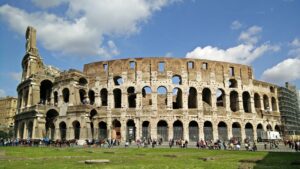
Tourists should visit the Colosseum, also known as the Flavian Amphitheater, which is one of the historical sites and a famous symbol of ancient Rome Italy located in the heart of the city.
It was built in the 1st century AD, this massive amphitheater was used for gladiatorial contests, animal hunts, and other public spectacles that entertained the Roman citizens.
With a seating capacity of up to 80,000 spectators, the Colosseum was a marvel of Roman engineering and architecture, showcasing the grandeur and power of the Roman Empire.
The Colosseum’s elliptical shape and towering exterior walls made it a formidable structure that still impresses visitors today.
Made of concrete and sandstone, the amphitheater stands as a testament to the craftsmanship and ingenuity of the ancient Romans.
The exterior facade features three levels of arches adorned with decorative elements, showcasing the architectural prowess of the time.
Despite centuries of wear and damage, the Colosseum remains one of the most visited landmarks in Rome, attracting millions of tourists each year.
Visitors can explore the interior of the amphitheater, marveling at the intricate network of tunnels, chambers, and seating areas that once hosted thrilling events.
The Colosseum’s history is rich and storied, reflecting the cultural significance of entertainment and spectacle in ancient Rome.
Today, the Colosseum stands as a symbol of Rome’s enduring legacy; furthermore, it serves as a reminder of the city’s vibrant past.
Its imposing presence and historical significance make it a must-see destination for travelers seeking to immerse themselves in the history and grandeur of ancient Rome.
2. The Vatican City Italy:
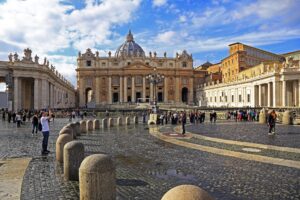
The Vatican City, officially known as the Vatican City State, is the smallest independent state in the world, located within the city of Rome, Italy.
It serves as the spiritual and administrative center of the Roman Catholic Church, home to the Pope and various important religious institutions.
Vatican City Italy is a UNESCO World Heritage Site and one of the historical sites and is also known for its cultural and historical importance for tourists.
One of the most iconic landmarks in Vatican City is St. Peter’s Basilica.
It is a magnificent Renaissance church designed by renowned architects such as Michelangelo and Gian Lorenzo Bernini.
The basilica’s dome is a prominent feature of the Vatican skyline and offers breathtaking views of the city.
Another must-visit attraction in Vatican City is the Sistine Chapel.
It is famous for its stunning frescoes painted by Michelangelo, including the renowned ceiling depicting scenes from the Book of Genesis.
The chapel is also where the Papal conclave takes place to elect a new Pope.
Visitors to the Vatican City can explore the Vatican Museums, which house an extensive collection of art and artifacts amassed by the Catholic Church over centuries.
The museums feature works by some of the greatest artists in history, including Raphael, Leonardo da Vinci, and Caravaggio.
Overall, Vatican City is a place of immense cultural, religious, and historical significance, attracting millions of visitors each year who come to marvel at its architectural wonders and artistic treasures.
3. The Leaning Tower of Pisa Italy:
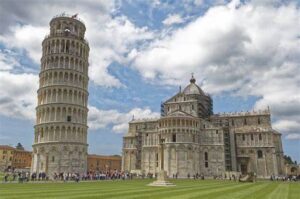
The Leaning Tower of Pisa, one of Italy’s most famous landmarks, is a freestanding bell tower located in the city of Pisa, Tuscany.
Construction of the tower began in the 12th century and, moreover, was completed over the course of two centuries.
The tower’s distinctive tilt is due to an unstable foundation and soft ground on one side, causing it to lean at an angle that has captured the fascination of visitors from around the world.
Standing approximately 56 meters tall, the Leaning Tower of Pisa is made of white marble and features a series of arcades and columns that add to its architectural beauty.
In general, the tower is adorned with intricate carvings and decorations, showcasing the craftsmanship of the medieval builders.
Despite efforts to stabilize the tower and prevent further leaning, it continues to be a symbol of architectural marvel and human ingenuity.
Visitors can climb the tower’s 294 steps to reach the top and enjoy panoramic views of the surrounding Piazza dei Miracoli (Square of Miracles) and the city of Pisa.
The Leaning Tower of Pisa is not only a UNESCO World Heritage Site but also a testament to the resilience and creativity of the human spirit.
It is one of the historical sites, Its unique tilt and historical significance make it a must-see destination for tourists exploring the beauty and history of Italy.
4. The ruins of Pompeii Italy:
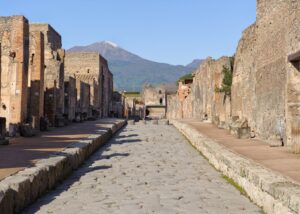
The ruins of Pompeii, located near Naples in Italy, are a fascinating archaeological site.
They offer a glimpse into the ancient Roman city that was buried under volcanic ash and pumice when Mount Vesuvius erupted in 79 AD.
The city was frozen in time by the eruption, preserving buildings, artifacts, and even the remains of its inhabitants, providing valuable insights into daily life during the Roman Empire.
Pompeii was a thriving city with a population of around 11,000 people, known for its prosperous economy, vibrant culture, and well-preserved architecture.
Visitors to the ruins of Pompeii can explore the remarkably preserved streets, houses, temples, theaters, and public buildings that offer a window into the past.
The city’s well-preserved frescoes, mosaics, and sculptures provide a vivid picture of Roman art and craftsmanship.
One of the most iconic structures in Pompeii is the Temple of Apollo, a grand temple dedicated to the Roman god of the sun.
The ruins of Pompeii also offer a haunting reminder of the tragic events that befell the city during the eruption of Mount Vesuvius.
The plaster casts of the victims, created by pouring liquid plaster into the cavities left by decomposed bodies, serve as a poignant memorial to the human toll of the disaster.
Overall, the ruins of Pompeii are a UNESCO World Heritage Site and a must-visit destination for history enthusiasts, archaeology buffs, and anyone interested in experiencing the ancient world firsthand.
5. The Florence Cathedral Italy:
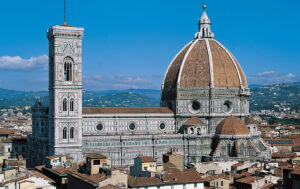
The Florence Cathedral, also known as the Cathedral of Santa Maria del Fiore, is a magnificent architectural masterpiece located in the heart of Florence, Italy.
Construction of the cathedral began in 1296 and was completed in 1436, making it one of the largest and most iconic cathedrals in Italy.
The cathedral is renowned for its stunning dome, designed by Filippo Brunelleschi, which stands as a symbol of Renaissance architecture and engineering prowess.
The exterior of the Florence Cathedral is adorned with intricate marble facades, elaborate sculptures, and beautiful stained glass windows that showcase the artistic talent of the Renaissance period.
The bell tower, known as Giotto’s Campanile, not only offers panoramic views of the city but also stands as a testament to the skilled craftsmanship of its builders.
Inside the cathedral, visitors can marvel at the grandeur of the interior, which features ornate frescoes, intricate mosaics, and a magnificent altar.
The cathedral houses priceless works of art, including sculptures by Donatello and Michelangelo, as well as stunning paintings by renowned artists.
The Florence Cathedral is not only one of the historical sites of Italy, a place of worship but also a cultural and historical landmark that attracts millions of tourists each year.
Its significance in the history of art and architecture, as well as its spiritual importance, makes it a must-see destination for travelers exploring the rich cultural heritage of Italy.
6. The Grand Canal in Venice Italy:
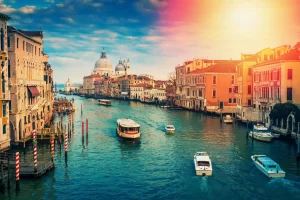
The Grand Canal in Venice, Italy, is a picturesque waterway that winds its way through the heart of the city, serving as the main thoroughfare for transportation and commerce.
Lined with stunning palaces, historic buildings, and bustling markets, the Grand Canal is a vibrant and iconic symbol of Venice’s unique charm and beauty.
The canal stretches for about 2.5 miles and is spanned by numerous bridges, including the famous Rialto Bridge. Additionally, it is home to the ornate Bridge of Sighs.
One of the best ways to experience the Grand Canal is by taking a leisurely gondola ride, gliding past elegant palazzos and historic landmarks while soaking in the romantic atmosphere of Venice.
Along the canal, visitors can admire architectural marvels such as the Gothic-style Ca’ d’Oro, the opulent Palazzo Grassi, and the majestic Basilica di Santa Maria della Salute.
The Grand Canal is also home to the annual Venetian tradition of the Regata Storica.
This historic rowing race dates back to the 13th century and attracts crowds of spectators who line the banks of the canal to cheer on the competing teams.
Whether exploring the canal by gondola, vaporetto (water bus), or simply strolling along its banks, the Grand Canal offers a captivating glimpse into the rich history and culture of Venice.
Its timeless beauty and enchanting ambiance make it a must-see destination for travelers seeking to immerse themselves in the magic of this iconic Italian city.
7. The Roman Forum Italy:
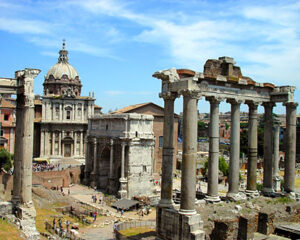
The Roman Forum, located in the heart of Rome, Italy, is a sprawling archaeological site that served as the political, religious, and social center of ancient Rome.
This historic complex is a captivating glimpse into the grandeur and power of the Roman Empire, showcasing a rich tapestry of ruins that tell the story of Rome’s illustrious past.
The Roman Forum was once a bustling hub of activity, where citizens gathered to conduct business, attend public speeches, worship at temples, and participate in civic events.
Today, visitors can wander through the ruins of ancient temples, basilicas, and government buildings.
They can marvel at the architectural feats of the Romans and imagine the vibrant life that once thrived in this bustling marketplace.
Key landmarks within the Roman Forum include the iconic Temple of Saturn, the majestic Arch of Septimius Severus, and the imposing Curia Julia.
The Curia Julia was where the Roman Senate convened to debate and make decisions that shaped the course of history.
The Forum also features the remains of the Temple of Vesta, the House of the Vestal Virgins, and the Rostra, a platform from which orators addressed the Roman people.
Exploring the Roman Forum is like stepping back in time to ancient Rome, where emperors, senators, and citizens once walked the same cobblestone streets and gathered in the same public squares.
The site’s rich history, stunning architecture, and archaeological significance make it a must-visit destination.
It attracts history enthusiasts and travelers seeking to immerse themselves in the legacy of one of the greatest civilizations in history.
8. The Uffizi Gallery in Florence Italy:
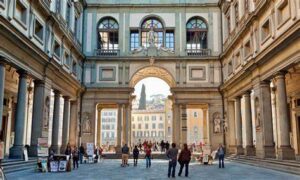
The Uffizi Gallery in Florence, Italy, is a world-renowned museum that houses one of the most impressive collections of Renaissance art in the world.
Located in the historic Palazzo degli Uffizi, the gallery showcases masterpieces by renowned artists such as Leonardo da Vinci, Michelangelo, Raphael, Botticelli, and Caravaggio, among others.
The Uffizi Gallery was originally built in the 16th century to house the administrative offices of the Florentine magistrates.
Over time, it evolved into a prestigious art museum that attracts art lovers and history enthusiasts from around the globe.
Visitors to the Uffizi Gallery can admire iconic works of art such as Botticelli’s “The Birth of Venus” and “Primavera,” Michelangelo’s “Tondo Doni,” and Leonardo da Vinci’s “Annunciation.”
The museum’s vast collection also includes ancient sculptures, medieval religious art, and Baroque paintings, offering a comprehensive overview of the evolution of art in Florence and beyond.
In addition to its impressive art collection, the Uffizi Gallery boasts stunning architecture, with grand halls, ornate ceilings, and sweeping views of the Arno River and the city of Florence.
The museum’s beautifully curated galleries and expertly displayed artworks make it a must-visit destination.
It attracts art enthusiasts and, moreover, travelers seeking to immerse themselves in the beauty and history of Renaissance art.
9. The Pantheon in Rome Italy:
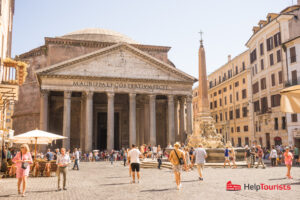
The Pantheon in Rome, Italy is a magnificent architectural marvel that has stood the test of time for over two thousand years.
Originally built by the Roman Emperor Hadrian in 126 AD, this iconic structure is a testament to the ingenuity and craftsmanship of ancient Roman engineers and architects.
One of the most striking features of the Pantheon is its massive dome, which was the largest in the world for over a millennium.
The dome is made of concrete and is supported by a series of arches, creating a breathtaking interior space that is both awe-inspiring and elegant.
The Pantheon was originally built as a temple to the Roman gods, but it has since been repurposed as a Christian church dedicated to St.Mary and the Martyrs.
Despite its change in religious affiliation, the Pantheon remains a symbol of Rome’s rich history and cultural heritage.
Visitors to the Pantheon can marvel at the intricate details of the building’s facade, which features a grand portico with towering columns and a massive bronze door.
Inside, the oculus at the top of the dome allows natural light to filter into the space, creating a mystical atmosphere that is truly unique.
Today, the Pantheon of Italy is one of the historical sites that attracts tourists from all over the world who come to admire its beauty and learn about its fascinating history.
Whether you are a history buff, an architecture enthusiast, or simply a curious traveler, a visit to the Pantheon is sure to leave you in awe of this ancient wonder.
10. The Amalfi Coast Italy:
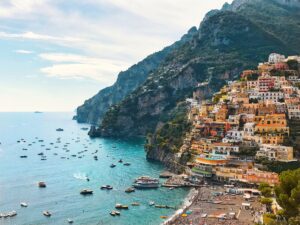
The Amalfi Coast, located in southern Italy, is a breathtaking stretch of coastline renowned for its stunning beauty and charming seaside towns.
With its dramatic cliffs, crystal-clear waters, and colorful villages perched on the hillsides, the Amalfi Coast is a popular destination for travelers seeking a mix of relaxation and adventure.
One of the most iconic towns along the coast is Positano, known for its pastel-colored buildings cascading down the cliffs towards the sea.
Visitors can wander through narrow streets lined with boutiques and cafes, or relax on the picturesque beaches with views of the rugged coastline.
Further along the coast is the town of Amalfi, from which the region takes its name.
Here, tourists can explore the historic cathedral of Saint Andrew, one of the historical sites of Italy, stroll through the charming piazzas, and sample delicious local cuisine at waterfront restaurants.
For those seeking a more active experience, the Amalfi Coast offers plenty of hiking opportunities.
The trails wind through lemon groves and vineyards, offering panoramic views of the Mediterranean Sea.
Whether you’re looking to relax on the beach, explore historic sites, or simply soak in the stunning scenery, the Amalfi Coast has something to offer every traveler.
With its unique blend of natural beauty and cultural heritage, it’s no wonder that this enchanting region continues to captivate visitors from around the world.







